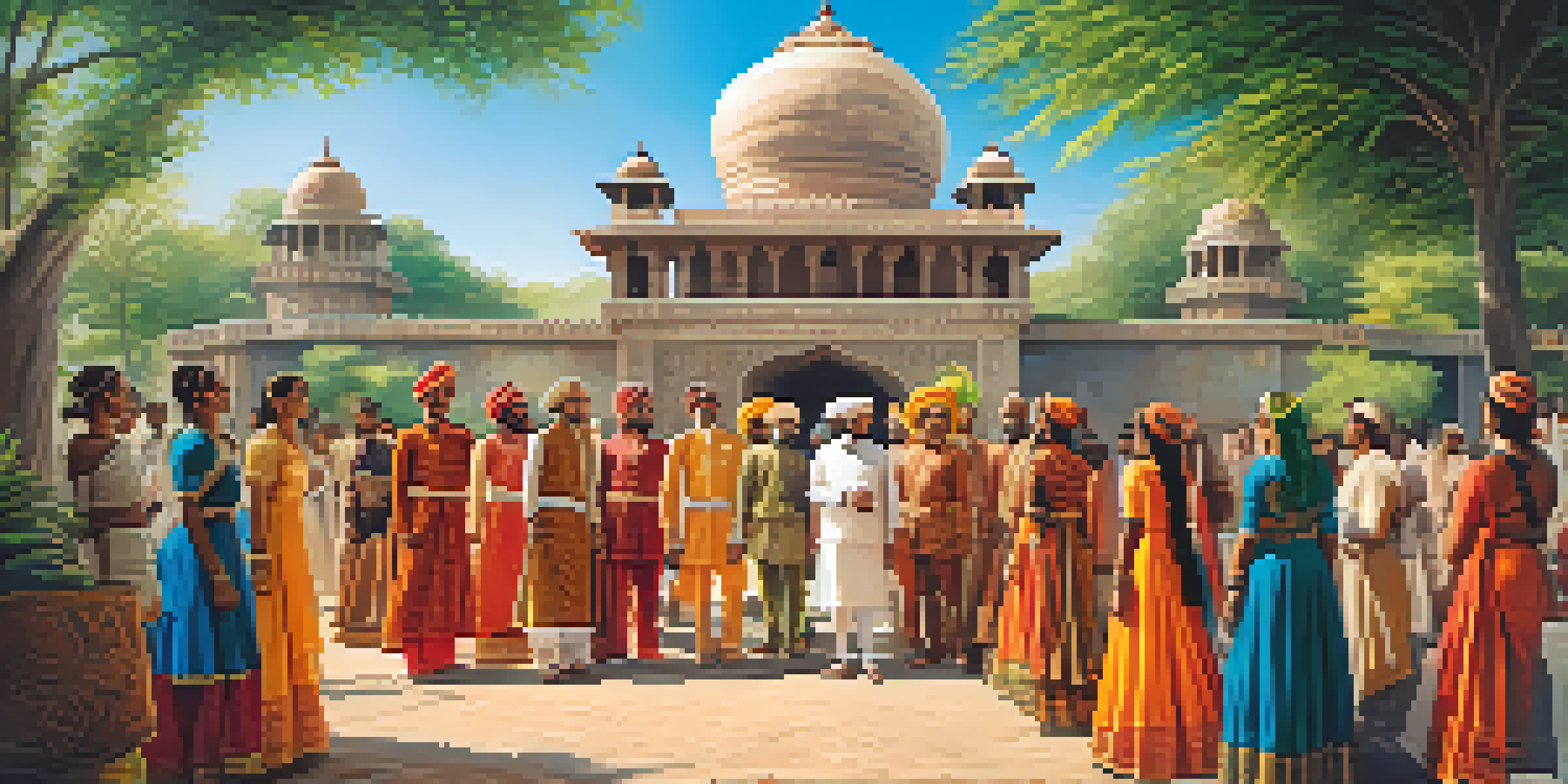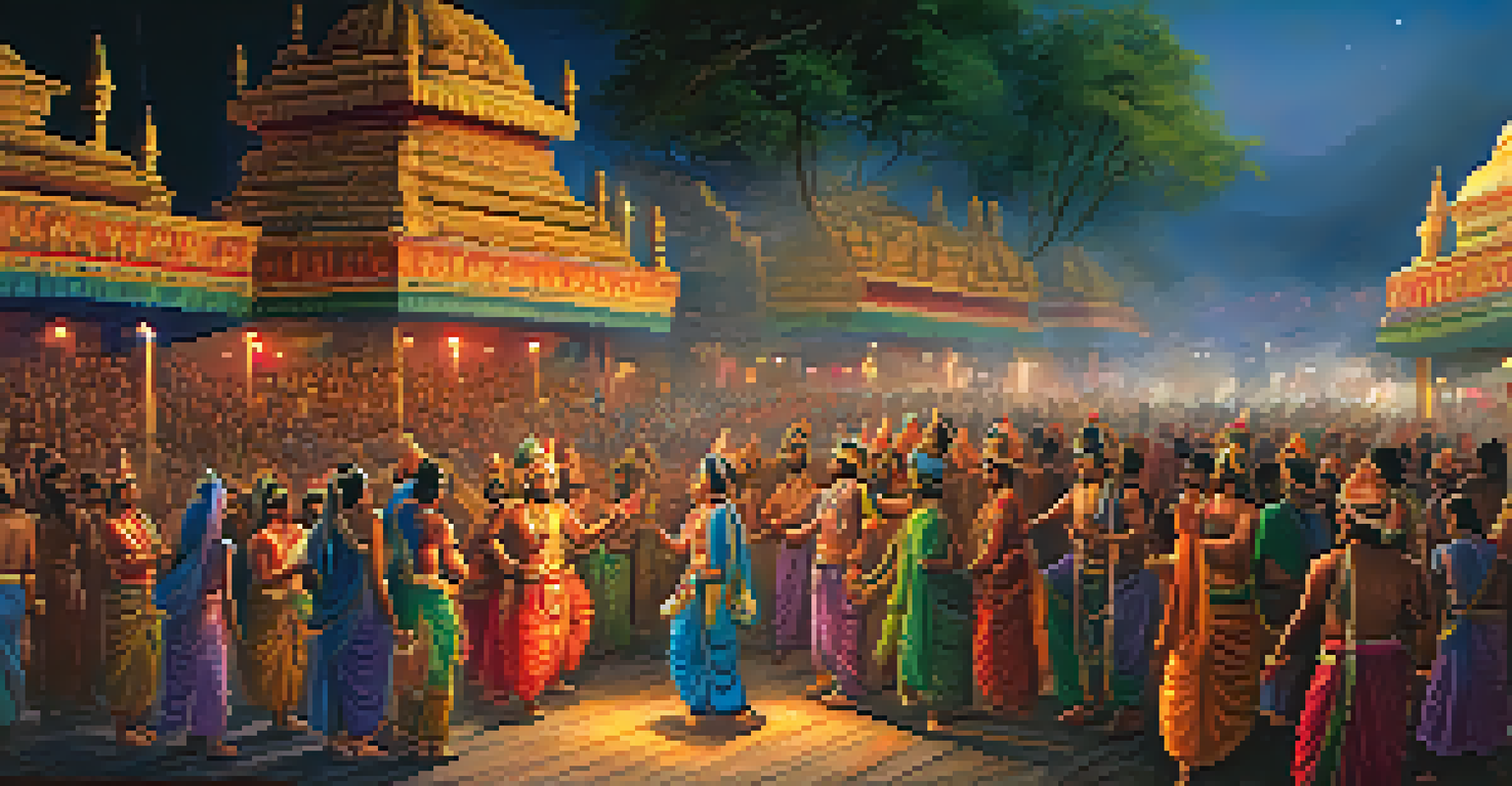Exploring India's Rich Heritage Through Historical Reenactments

Understanding Historical Reenactments in India
Historical reenactments are a unique way to bring the past to life, allowing people to experience history firsthand. In India, these reenactments often draw from the country's rich tapestry of cultures, traditions, and events that have shaped its identity. They serve not only as entertainment but also as a means of education, helping audiences appreciate the complexities of Indian history.
History is not a burden on the memory but an illumination of the soul.
Participants immerse themselves in roles that reflect historical figures, complete with period-appropriate costumes and settings. This attention to detail creates a vivid portrayal of significant moments, from ancient battles to royal court life. The emotional connection formed through participation enhances understanding and fosters a sense of belonging within the cultural narrative.
Moreover, these reenactments often encourage community involvement, bringing together people of all ages. By engaging in storytelling through performances, communities can bond over shared heritage, ensuring that these stories are passed down through generations. This blend of education and entertainment makes historical reenactments a powerful tool for cultural preservation.
Key Historical Events Showcased in Reenactments
India's history is filled with remarkable events, many of which are brought to life through reenactments. One popular example is the reenactment of the legendary battles from the Mahabharata, showcasing not just the conflict but also the moral dilemmas faced by its characters. Such performances allow audiences to explore ethical questions while enjoying dramatic storytelling.

Another significant event often depicted is the struggle for independence from British rule. Reenactors portray key figures like Mahatma Gandhi and Subhas Chandra Bose, highlighting their contributions and sacrifices. These reenactments serve as a poignant reminder of the nation's journey toward freedom and the values that shaped modern India.
Cultural Education through Reenactments
Historical reenactments serve as engaging educational tools, allowing participants to experience and appreciate India's rich heritage.
Festivals like Dussehra and Holi also feature reenactments, transforming public spaces into vibrant stages. The dramatization of the Ramayana during Dussehra not only entertains but also reinforces cultural values such as good triumphing over evil. Each event brings history closer to contemporary life, making it relevant and relatable.
The Role of Technology in Modern Reenactments
In recent years, technology has revolutionized how historical reenactments are produced and experienced. With advancements in sound and lighting, performances can now be more immersive, drawing audiences into the historical narrative. For instance, virtual reality (VR) experiences have emerged, allowing viewers to step into key moments in history.
The past is never dead. It's not even past.
Additionally, social media plays a significant role in promoting these events, reaching a broader audience. By sharing behind-the-scenes content and engaging with viewers online, organizers can create excitement and anticipation around upcoming reenactments. This digital connection also encourages discussions about historical significance and cultural pride.
Moreover, the use of modern technology doesn't dilute the authenticity of these reenactments; instead, it enhances the storytelling aspect. The combination of traditional practices with contemporary tools creates a richer experience, bridging the gap between the past and present. This innovative approach ensures that historical reenactments remain engaging and relevant to today's audiences.
Fostering Cultural Awareness Through Reenactments
Historical reenactments play a crucial role in fostering cultural awareness and appreciation among diverse communities. By showcasing various aspects of India's heritage, these events help bridge gaps between different cultures and promote understanding. Participants and audiences alike gain insights into the customs and traditions of their neighbors, nurturing a sense of unity.
These reenactments often highlight lesser-known stories from history, shedding light on the contributions of various communities. By bringing these narratives to the forefront, organizers create an inclusive environment that celebrates diversity. This approach encourages dialogue and reflection, allowing participants to engage with history on a personal level.
Technology Enhances Historical Events
Modern technology, including virtual reality and social media, significantly enriches the production and experience of historical reenactments.
As more people become involved in historical reenactments, the opportunity for cultural exchange expands. Attendees can interact with performers, ask questions, and share their perspectives, enriching the overall experience. This exchange of ideas not only enhances knowledge but also fosters respect for different cultural backgrounds.
Challenges Faced in Historical Reenactments
While historical reenactments can be incredibly rewarding, they also face several challenges. One major issue is ensuring historical accuracy, as dramatizing events can sometimes lead to the oversimplification or misrepresentation of facts. Organizers need to strike a balance between engaging storytelling and authentic representation to maintain credibility.
Funding is another significant challenge, as many reenactment groups rely on donations and sponsorships to cover costs. Limited budgets can affect the quality of costumes, props, and venues, which in turn impacts the overall experience for both participants and audiences. Creative solutions, such as community fundraising and partnerships, are often necessary to sustain these initiatives.
Moreover, there can be resistance from some community members who may view reenactments as trivializing serious historical events. Addressing these concerns requires thoughtful dialogue and sensitivity to differing perspectives. By fostering open communication, organizers can work towards creating events that honor the past while being inclusive and respectful.
Education and Historical Reenactments: A Perfect Match
Educational institutions across India are increasingly incorporating historical reenactments into their curricula. This hands-on approach to learning engages students in a way that textbooks often cannot. By stepping into the shoes of historical figures, students develop a deeper understanding of events and their implications.
Many schools and colleges organize reenactment events to complement their history lessons, making learning more interactive. Students enjoy performing various roles, which not only boosts their confidence but also encourages teamwork and creativity. This experiential learning can lead to a lasting interest in history and culture.
Community Involvement is Essential
Successful historical reenactments rely on active community participation to ensure authenticity, funding, and cultural exchange.
Additionally, educational reenactments can extend beyond the classroom, involving parents and the community. Workshops and community events can provide a platform for students to showcase their learning while educating others about India's heritage. This collaborative effort enriches the learning experience and fosters a sense of pride in cultural history.
Future of Historical Reenactments in India
As interest in historical reenactments continues to grow, the future looks promising for this vibrant cultural practice. With the rise of tourism focused on heritage experiences, reenactments can attract visitors eager to learn about India's rich history. This potential for cultural tourism can provide a boost to local economies while preserving traditions.
Innovative approaches, such as thematic festivals and collaborative events, could further enhance the appeal of reenactments. By partnering with local artists, historians, and cultural organizations, reenactments can evolve into multifaceted experiences that showcase diverse aspects of Indian heritage. This collaborative spirit can create a more dynamic and engaging atmosphere for participants and audiences alike.

Ultimately, the success of historical reenactments will depend on community involvement and support. As more people recognize the importance of preserving and sharing their heritage, reenactments will continue to flourish. By celebrating India's past through these captivating performances, we ensure that future generations remain connected to their cultural roots.